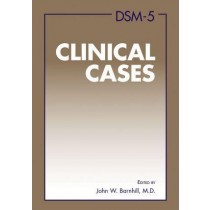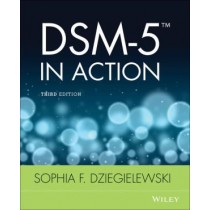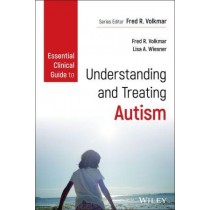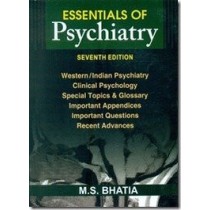Psychiatry
-

DSM-5 Clinical Cases
Pages: 402,
Specialty: Psychiatry,
Publisher: APA,
Publication Year: 2014,
Cover: Paperback,
Dimensions: 180.34x254x17.78mm
DSM-5 (R) Clinical Cases presents patient cases that exemplify the mental disorders categorized in the newly released DSM-5 (R), bringing DSM-5 (R) alive for teachers and students of psychiatry, psychology, social work, nursing, and related mental health and healthcare fields. Cases are cross-referenced with DSM-5 (R) and help the reader understand diagnostic concepts, including symptoms, severity, comorbidities, age of onset and development, dimensionality across disorders, and gender and cultural implications.Every feature in the book helps to bridge the distance between the formal classification and the real-life presentation of patients: A All cases are original and previously unpublished, making for fresh, compelling reading for both experienced clinicians and those new to diagnostic classification. Case authors were selected for their expertise in the disorder described in the case. For ease in identifying specific cases, case titles are clinically relevant, based on the primary complaint, and identify the DSM-5 (R) diagnosis described.A Each case adheres to a consistent format developed by the editors to fully illuminate the disorder being profiled. Features may include history of present illness, family psychiatric history, medical history, mental status exam results, DSM-5 (R) diagnostic features, lab and physical findings, and a summary.A A brief discussion follows each case, analyzing the clinical presentation, highlighting key points, and exploring issues of comorbidity that may complicate both the diagnosis and subsequent treatment. This approach is especially helpful since few cases in real-life are unambiguous.A Easy-to-use appendixes enable readers to locate cases by type of disorder, special interests, and DSM-5 (R) diagnosis.A The book is designed to serve as a companion text in a variety of contexts -- from abnormal psychology courses to medical school and residency training programs. In addition, those studying for specialty examinations will find reviewing the cases very useful. Fascinating, practical, and instructive, DSM-5 (R) Clinical Cases succeeds in bringing the DSM-5 (R) to the examining room.show more
Weight: 0.64 KG
Learn MoreKWD32.39 -

DSM-5 Guidebook: The Essential Companion to the Diagnostic and Statistical Manual of Mental Disorders
Pages: 567,
Specialty: Psychiatry,
Publisher: APA,
Publication Year: 2014,
Cover: Paperback,
Dimensions: 177.8x254x25.4mm
DSM-5 (R) Guidebook: The Essential Companion to the Diagnostic and Statistical Manual of Mental Disorders, Fifth Edition is a user-friendly, supplementary guide for psychiatrists, psychologists, and other mental health practitioners who need to know how DSM-5 (R) differs from its predecessor in terms of organizational structure, diagnostic categories, and the criteria themselves. While it does not replace the comprehensive and authoritative DSM-5 (R), it illuminates its content by teaching mental health professionals how to use the revised diagnostic criteria and by providing a practical context for its clinical use.The book offers many valuable features, including: A An historical overview of the development of the DSM in general, and DSM-5 (R) in particular, a progression that might be said to mirror the evolution of psychiatry as a whole. The material on the creation of DSM-5 (R) includes coverage of dimensional assessment, reliability and field trials, and the controversies that arose during development of DSM-5 (R).A An indispensable chapter on how to use DSM-5 (R) that addresses coding, diagnostic certainty, the demise of the multiaxial system, and the key changes to each diagnostic category.A Full coverage of the significant reorganization from DSM-IV-TR (R) to DSM-5 (R), which is designed to incorporate advances in neuroscience, brain imaging and genetics. Chapters were reordered to reflect scientific advances in the understanding of psychiatric disorders, and the presumed etiological and the pathophysiological relationships among them.A Extensive coverage of the decision to integrate dimensional measures into DSM-5 (R), which may enhance the clinician's ability to assess symptom variation and severity and aid in patient evaluation, treatment decisions, and outcome monitoring. The various measures are presented and their use discussed.A Finally, as the authors were not part of the revision process, they offer a fresh, down-to-earth perspective that will resonate with clinicians by focusing on the changes that will most significantly impact clinicians' professional lives. DSM-5 (R) Guidebook provides a roadmap to the many changes in this living document, DSM-5 (R), and will prove invaluable to psychiatrists, psychologists, psychiatric nurses, neurologists, social workers, and all who strive to understand mental illness as it is conceived today.show more
Weight: 0.86 KG
Learn MoreKWD23.39 -

DSM-5 in Action
Pages: 608,
Specialty: Psychiatry,
Publisher: Wiley,
Publication Year: 2014,
Cover: Paperback,
Dimensions: 190x232x28mm
Full exploitation of the DSM-5 allows for more comprehensive care By demystifying the DSM-5, author Sophia Dziegielewski goes beyond the traditional diagnostic assessment and suggests both treatment plans and practice strategy. She covers the changes in criteria to the DSM-5 and what those changes mean for mental health professionals. This resource has been updated to include: * New and updated treatment plans * All treatment plans, interventions strategies, applications, and practice implications are evidence based * Instructions on doing diagnostic assessments and differential diagnosis using the DSM-5 * Changes to coding and billing using the DSM-5 and ICD-10 The book includes robust tools for students, instructors, and new graduates seeking licensure. DSM-5 in Action makes the DSM-5 accessible to all practitioners, allowing for more accurate, comprehensive care.
Weight: 1.02 KG
Learn MoreKWD28.19 -

DSM-5 Self-Exam Questions: Test Questions for the Diagnostic Criteria
Pages: 479,
Specialty: Psychiatry,
Publisher: APA,
Publication Year: 2014,
Cover: Paperback,
Dimensions: 175.26x251.46x15.24mm
DSM-5 (R) Self-Exam Questions: Test Questions for the Diagnostic Criteria elucidates DSM-5 (R) through self-exam questions designed to test the reader's knowledge of the new edition's diagnostic criteria. Mental health professionals, ranging from clinicians and students to psychiatric nurses and social workers, will benefit from this substantive text's 300-plus questions. This book is a "must have" for anyone seeking to fully understand the changes brought about by the groundbreaking launch of DSM-5 (R). Some of the book's most beneficial features include: A Self-exam questions and cases designed to test the reader's knowledge of conceptual changes to DSM-5 (R) (e.g., autism spectrum disorder), specific changes to diagnoses (e.g., the integration of childhood disorders within main disorders), and diagnostic criteria (e.g., the diagnostic criteria for major depressive disorder and bipolar disorders).A Questions about each diagnosis in DSM-5 (R), including the proposed diagnoses in Section III, which enable readers to teach themselves about new and potential future diagnoses.A A contrast of DSM-5 (R) diagnoses with DSM-IV-TR (R) to assist readers in quickly learning about the changes in diagnostic classes and criteria.A Short answers that explain the rationale for each correct answer (diagnostic criteria sets from DSM-5 (R) are included as appropriate, and readers are directed to DSM-5 (R) for further information).A Question answers containing important information on diagnostic classifications, criteria sets, diagnoses, codes, and severity, dimension of diagnosis, and culture, age, and gender. Straightforward, practical, and illustrative, DSM-5 (R) Self-Exam Questions: Test Questions for the Diagnostic Criteria will successfully test and broaden the DSM-5 (R) knowledge of all mental health professionals.show more
Weight: 0.7 KG
Learn MoreKWD22.19 -

DSM-5TM Handbook of Differential Diagnosis
Pages: 338,
Specialty: Psychiatry,
Publisher: APA,
Publication Year: 2014,
Cover: Paperback,
Dimensions: 177.8x251.46x15.24mm
The DSM-5 (R) Handbook of Differential Diagnosis is the preeminent guide to differential diagnosis for both clinicians and students learning psychiatric diagnosis. Based closely on the Diagnostic and Statistical Manual of Mental Disorders, Fifth Edition, it offers a rich selection of perspectives in an easy-to-use format. The author, an expert on psychiatric diagnosis and assessment, recognizes that psychological distress cannot be reduced to a rubric. The clinician must have empathy, listening skills, the ability to identify symptoms and contextualize them, and a familiarity with the body of knowledge represented by DSM-5 (R). The handbook brings these critical skills together in a well-written, accessible, and reader-friendly volume that is grounded in the latest research and standard of practice.The handbook offers an assortment of approaches to differential diagnosis, and a number of features designed to benefit clinicians in the exam room, including: A A six-step framework for diagnosing patients that proceeds from determining if the symptom is real to establishing the boundary between disorder and normality, with intermediary steps to rule out substance etiology and medical conditions, as well as to determine the primary disorder and to differentiate adjustment disorders from other mental disorders.A Twenty-nine symptom-oriented decision trees that provide detailed decision points to facilitate the process of generating the differential diagnosis based on the presenting symptoms and eliminate formulating premature conclusions.A Sixty-six differential diagnosis tables, one for each of the most important DSM-5 (R) disorders, cross-referenced with the terminal branches of the decision trees presented in the handbook to provide a head-to-head comparison of each disorder, highlighting similarities and differences.A The DSM-5 (R) classification, to facilitate coding and to provide an overview of all of the DSM-5 (R) diagnoses that must be considered in formulating a differential diagnosis.A Alphabetical indexes of the decision trees and differential diagnosis tables to help readers readily locate desired material. DSM-5 (R) Handbook of Differential Diagnosis provides a comprehensive overview of the process of diagnosing DSM-5 (R) disorders while serving as a reference guide to assist in the differential diagnosis of individual patients. The handbook is an invaluable addition to the DSM-5 (R) collection and an important contribution to the mental health profession.show more
Weight: 0.48 KG
Learn MoreKWD35.99 -

DSM-5® Classification
Pages: 183,
Specialty: Psychiatry,
Publisher: APA,
Publication Year: 2015,
Cover: Spiral bound,
Dimensions: 106x165x5.08mm
This handy DSM-5 (R) Classification provides a ready reference to the DSM-5 classification of disorders, as well as the DSM-5 listings of ICD-9-CM and ICD-10-CM codes for all DSM-5 diagnoses. To be used in tandem with DSM-5 (R) or the Desk Reference to the Diagnostic Criteria From DSM-5 (R), the DSM-5 (R) Classification makes accessing the proper diagnostic codes quick and convenient.With the advent of ICD-10-CM implementation in the United States on October 1, 2015, this resource provides quick access to the following: A The DSM-5 (R) classification of disorders, presented in the same sequence as in DSM-5 (R), with both ICD-9-CM and ICD-10-CM codes. All subtypes and specifiers for each DSM-5 (R) disorder are included.A An alphabetical listing of all DSM-5 diagnoses with their associated ICD-9-CM and ICD-10-CM codes.A Separate numerical listings according to the ICD-9-CM codes and the ICD-10-CM codes for each DSM-5 (R) diagnosis.A For all listings, any codable subtypes and specifiers are included with their corresponding ICD-9-CM or ICD-10-CM codes, if applicable. The easy-to-use format will prove indispensable to a diverse audience -- for example, clinicians in a variety of fields, including psychiatry, primary care medicine, and psychology; coders working in medical centers and clinics; insurance companies processing benefit claims; individuals conducting utilization or quality assurance reviews of specific cases; and community mental health organizations at the state or county level.show more
Weight: 0.51 KG
Learn MoreKWD15.89 -

Essential Clinical Guide to Understanding and Treating Autism
Pages: 368,
Specialty: Psychiatry,
Publisher: Wiley,
Publication Year: 2018,
Cover: Paperback,
Dimensions: 153x227x24mm
Coauthored by the premier expert on autism in the United States and an experienced academic and practicing pediatrician, this volume provides concise and practical information based on the most up-to-date research and clinical experience for primary care givers around the world. Showing clinicians how to most effectively use evidence-based techniques, this invaluable guide offers primary-care providers access to expert, current research and practice guidelines allowing them to confidently support children who present with symptoms of autism. show more
Weight: 0.48 KG
Learn MoreKWD20.39 -

Essentials of Psychiatry in Primary Care: Behavioral Health in the Medical Setting
Pages: 208,
Specialty: Psychiatry,
Publisher: McGraw-Hill,
Publication Year: 2019,
Cover: Paperback
An innovative psychiatry textbook that presents behavioral disorders from the perspective of what is seen in medical settings The goal of Essentials of Psychiatry in Primary Care is not to make psychiatrists out of medical clinicians, but rather, to help clinicians manage common behavioral conditions that most often present in a medical setting. Essentials of Psychiatry in Primary Care seeks to integrate medicine and psychiatry --- as the authors' systems-based biopsychosocial model proposes. The book identifies physical symptoms as a common mode of presentation of mental health problems and describes how to integrate them with psychological symptoms to make diagnoses of mental disorders. Essentials of Psychiatry in Primary Care also details a behaviorally defined, evidence-based mental healthcare model that can be effectively used in a medical setting. The combined experiences in primary care of the authors --- who specialize in both general internal medicine and psychiatry --- provide the perfect background for a book of this nature. Having trained medical students, as well as internal and family medicine residents since 1986, their experience and research demonstrates the information they outline is effective and associated with improved mental and physical health outcomes. show more
Weight: 1 KG
Learn More -

Essentials of Psychiatry, 7e
Pages: 932,
Specialty: Psychiatry,
Publisher: CBS,
Publication Year: 2013,
Cover: Paperback
Weight: 0 KG
Learn MoreKWD9.00 -

Eureka: Psychiatry
Pages: 305,
Specialty: Psychiatry,
Publisher: JP Medical,
Publication Year: 2016,
Cover: Paperback,
Dimensions: 160x240x17mm
Eureka - an innovative series for students that fully integrates core science, clinical medicine and surgery. With its engaging and authoritative text, featuring insightful clinical cases, graphic narratives, SBAs and a wealth of other learning tools, Eureka has everything students need to succeed in medicine and pass their exams. Series features across titles: * Engaging clinical cases show how skilled clinician would work through a presentation, and put diseases and biomedical principles into patient context * Innovative graphic narratives bring clinical cases to life, show how to approach difficult scenarios and convey the experience of being a patient *Starter questions - stimulating answers to intriguing questions make learning fun *Boxes highlight tips, tricks and key learning points Psychiatry *First principles chapter clearly explains the key concepts and processes that underpin psychiatric disorders *Clinical essentials chapter provides an overview of the symptoms and signs of psychiatric disorders, relevant history and examination techniques, investigations and management options *Disease-based chapters give concise descriptions of all major disorders, e.g. anxiety, substance misuse and learning disabilities, each chapter introduced by engaging clinical cases that feature unique graphic narratives *Emergencies chapter covers the principles of immediate care in situations, such as violent patients and suicidal behaviour *Integrated care chapter discusses strategies for the management of chronic conditions across primary and other care settings *Self-Assessment - 80 multiple choice questions clinical SBAs
Weight: 0.52 KG
Learn MoreKWD14.40


